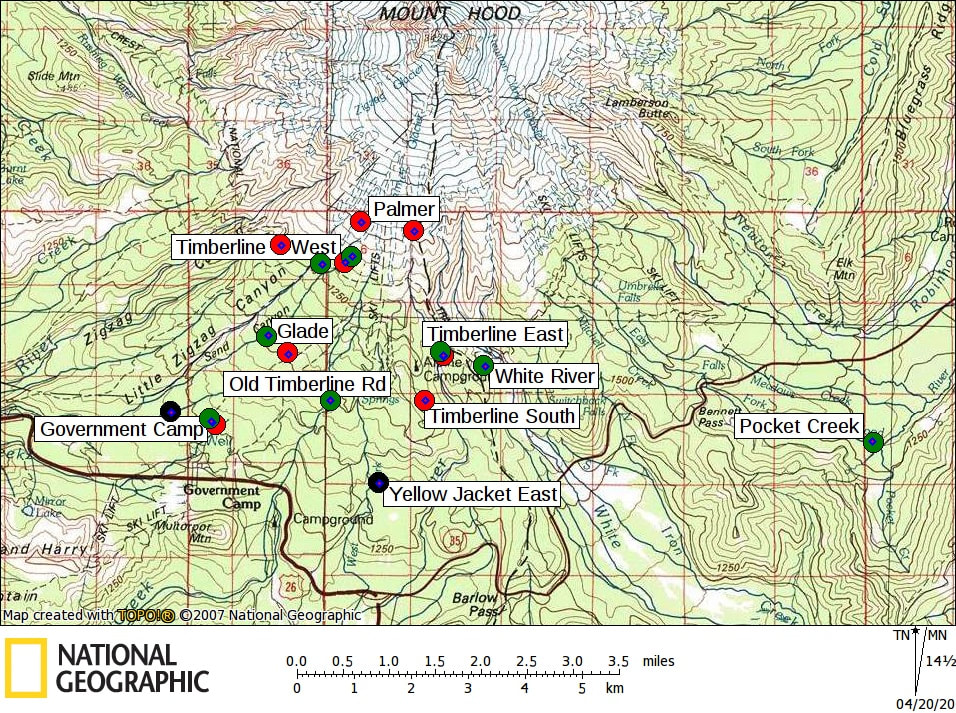Cascadia Wildlife Blog
News from the Wolverine Tracking Project and more
|
The days are getting warmer and longer, the birds are returning from winter migration, and animals everywhere are bringing a new generation of wildlife into our forests...needless to say, winter has ceased and made way for spring, marking the end of our winter survey season. While this season may have been unexpectedly cut short, the Cascadia Wild team of volunteers and members still managed to bring in countless wonderful photos and record many wildlife tracks while it lasted. Please enjoy this season recap of the Wolverine Tracking Project's Camera and Tracking Survey highlights! CAMERA SURVEYSThis winter season, a total of 1,447 volunteer hours went into camera survey trips! Together, we maintained a total of 21 cameras at 25 camera sites over the winter season. Over the survey year (which ran from Summer 2019 through Winter 2019-20), our camera sites were divided into two general areas: those near Mt. Hood, and those near the eastern edge of the National Forest boundary, with the intention of targeting different kinds of animals.  This map shows the cameras from the past year in the Mt. Hood area Summer 2019 and Winter 2019-20. The red dots are summer camera locations, the green dots are winter camera locations, and the black dots are year-round cameras. This map shows the cameras in the eastern forest boundary area Summer 2019 and Winter 2019-20. The red dots are summer camera locations, the green dots are winter camera locations, and the black dots are year-round cameras. The tables below show the animals detected at each site over the winter season: A total of 18 different animal species were detected by our cameras, along with a few mystery species pictured below... Our cameras even captured 3 different target species! The beautiful Sierra Nevada red fox was pictured at 4 separate camera sites this winter! Another target species, the gray wolf, was seen at 2 camera sites... And our final target species was pictured at one camera site: the Pacific marten! While these target species are incredibly exciting to capture on camera, so are the many other animals that passed through our camera sites! Our most frequent visitor was present at over 64% of all camera sites this winter... You guessed it: the coyote! Another frequent visitor was the black-tailed deer, present at 52% of our overall camera sites, and over 92% of the eastern forest boundary sites! Deer weren't the only ungulates spotted in our forests this winter. Elk were present at 5 different camera sites, all in the eastern forest boundary: Appearing at 10 camera sites, the bobcat was another regular: The largest felid in our forests, the mountain lion, was present at only 1 camera site this winter: The black bear was seen at 2 camera sites this winter, including once with some cubs! Many forest rodent inhabitants made their way into our camera sites, such as squirrels and mice. Can you spot tell which is a Douglas squirrel and which is our native, nocturnal Northern flying squirrel below? Snowshoe hares were present at 8 camera sites... And luckily, we only faced minor sabotage by the striped skunks, who made their way into 5 different camera sites... A huge THANK YOU to all of the volunteers that made this winter season so great - we look forward to another great summer survey season! tracking surveysThis winter season, a total of 1,213.5 volunteer hours were put into tracking surveys! In total, 47.5 miles were surveyed for tracks at 11 different transect locations! The map below shows the locations of our tracking trips this season. Thanks to all your hard work and attentive tracking, 279 total tracks were recorded, consisting of 8 different species and some mystery tracks! This table shows our tracking totals for the winter season: By and large, our winter tracks were dominated by snowshoe hare and squirrel prints. Pictured below are squirrel tracks (left) alongside snowshoe hare tracks (right). This season, a total of 117 squirrel tracks were recorded, the most of any species this season! Second in frequency to squirrel were snowshoe hare, with a total of 113 tracks! Another frequent sight on these tracking surveys was the deer mouse, with a total of 21 tracks recorded. Weasel tracks were recorded a total of 13 times: Our tracking teams even picked up a target species: the Pacific marten! A total of 6 coyote tracks were seen... ...and a total of 9 bobcat tracks Our volunteers also found some beautiful raven tracks in the snow! Some mystery tracks were not clear enough to properly identify... Along with animal tracks, our wildlife tracking teams also found other signs of wildlife in our forests, including these small sticks that indicate a small animal chewing the cambium for food... ...and a tree with signs of bark removal at the base (perhaps from a bear eating the cambium), consumption of the exposed inner tree by insects, and finally, marks left by a woodpecker eating the insects inside the tree. So much history visible in one tree! Near the base of this sign post are marks left by a bear: Our tracking teams also found a small mystery den: With so many animal signs recorded - both tracks and otherwise - it has undoubtedly been a very successful winter tracking season! Want to learn more about wildlife on Mt Hood?
Summer survey seasonAll in-person classes and events have been cancelled for the time being (read our COVID-19 Statement). However, we are hopeful, planning on, and looking forward to our summer survey wildlife survey season.
0 Comments
Leave a Reply. |
Categories
All
Past Posts
May 2024
|
|
|
Copyright © 2021
|